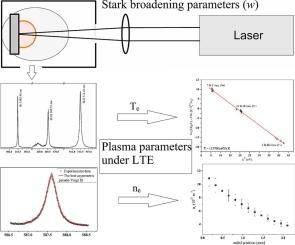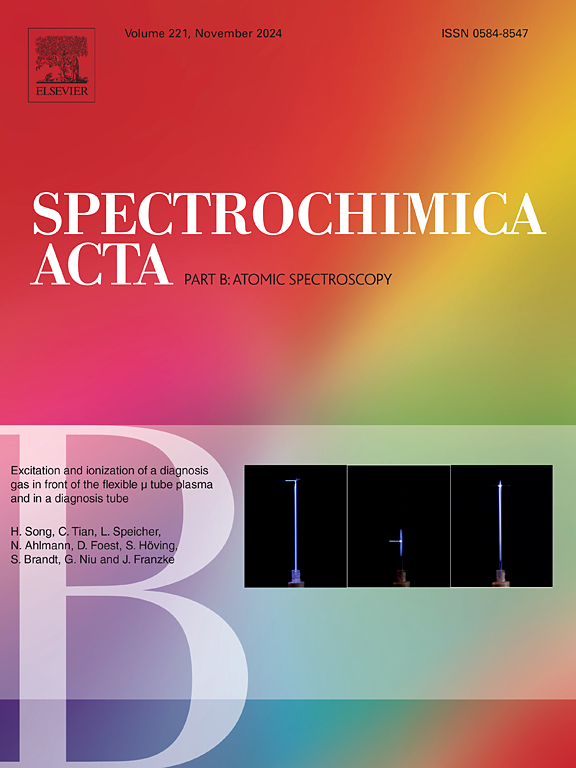Experimental stark broadening parameters of Bi I, Bi II and Bi III spectral lines in laser-induced plasma
IF 3.8
2区 化学
Q1 SPECTROSCOPY
引用次数: 0
Abstract
We present experimentally determined Stark width parameters (w - Full Width at Half Maximum) for 5 neutral (Bi I), 13 singly (Bi II), and 3 doubly ionized (Bi III) bismuth atoms spectral lines in the wavelength range of 298 to 570 nm. The experiment was conducted with a Laser-Induced Plasma (LIP) in helium gas at reduced pressure, as a source of spectra recorded in side-on geometry. Plasma parameters were estimated after applying the inverse Abel transform to the laterally resolved LIP profiles. The widths and relative intensities of all selected bismuth spectral lines were determined by their fit to the Voigt function. Electron number density values, on different plasma radial positions, were estimated in the range of (0.3–1.1) × 1023 m−3 based on the Stark broadening of the well-established diagnostic He I 587.56 nm spectral line. The electron temperature was determined using the Saha-Boltzmann method. Bismuth spectral lines were used to construct a Saha-Boltzmann plot for three consecutive ionization states of bismuth atoms, assuming Local Thermodynamic Equilibrium (LTE) in the LIP. These methods for determining electron number density and electron temperature enabled precise estimation of plasma parameters, and therefore also supported the accurate determination of the newly measured Stark width values of bismuth spectral lines. The experimental measurements in this study provided the first-ever data on Stark widths for selected specific bismuth spectral lines, not previously available according to the NIST database, which are suitable for further plasma diagnostics, astrophysical modeling, and the development of spectroscopic techniques in laboratory and industrial applications. We also discussed a well-known feature of bismuth, the hyperfine structure of spectral lines due to nuclear spin and associated magnetic moment.

激光诱导等离子体中Bi I、Bi II和Bi III谱线的实验stark展宽参数
本文通过实验确定了5个中性(Bi I)、13个单电离(Bi II)和3个双电离(Bi III)铋原子谱线在298 ~ 570 nm波长范围内的Stark宽度参数(w -半最大全宽度)。实验是用减压氦气中的激光诱导等离子体(LIP)进行的,作为侧面几何形状记录的光谱源。在对横向分辨的LIP剖面应用逆Abel变换后,估计了等离子体参数。所有选定的铋谱线的宽度和相对强度由它们对Voigt函数的拟合来确定。在等离子体径向位置的电子数密度值在(0.3-1.1)× 1023 m−3范围内,基于已建立的诊断He I 587.56 nm谱线的Stark拓宽。电子温度用Saha-Boltzmann法测定。利用铋谱线构建了铋原子连续三种电离状态的Saha-Boltzmann图,假设在LIP中存在局部热力学平衡(LTE)。这些确定电子数密度和电子温度的方法可以精确估计等离子体参数,因此也支持精确测定铋谱线的斯塔克宽度值。本研究中的实验测量首次提供了选定特定铋谱线的斯塔克宽度数据,这是NIST数据库以前无法获得的,适用于进一步的等离子体诊断、天体物理建模以及实验室和工业应用中光谱技术的发展。我们还讨论了铋的一个众所周知的特征,即由核自旋和相关磁矩引起的光谱线的超精细结构。
本文章由计算机程序翻译,如有差异,请以英文原文为准。
求助全文
约1分钟内获得全文
求助全文
来源期刊
CiteScore
6.10
自引率
12.10%
发文量
173
审稿时长
81 days
期刊介绍:
Spectrochimica Acta Part B: Atomic Spectroscopy, is intended for the rapid publication of both original work and reviews in the following fields:
Atomic Emission (AES), Atomic Absorption (AAS) and Atomic Fluorescence (AFS) spectroscopy;
Mass Spectrometry (MS) for inorganic analysis covering Spark Source (SS-MS), Inductively Coupled Plasma (ICP-MS), Glow Discharge (GD-MS), and Secondary Ion Mass Spectrometry (SIMS).
Laser induced atomic spectroscopy for inorganic analysis, including non-linear optical laser spectroscopy, covering Laser Enhanced Ionization (LEI), Laser Induced Fluorescence (LIF), Resonance Ionization Spectroscopy (RIS) and Resonance Ionization Mass Spectrometry (RIMS); Laser Induced Breakdown Spectroscopy (LIBS); Cavity Ringdown Spectroscopy (CRDS), Laser Ablation Inductively Coupled Plasma Atomic Emission Spectroscopy (LA-ICP-AES) and Laser Ablation Inductively Coupled Plasma Mass Spectrometry (LA-ICP-MS).
X-ray spectrometry, X-ray Optics and Microanalysis, including X-ray fluorescence spectrometry (XRF) and related techniques, in particular Total-reflection X-ray Fluorescence Spectrometry (TXRF), and Synchrotron Radiation-excited Total reflection XRF (SR-TXRF).
Manuscripts dealing with (i) fundamentals, (ii) methodology development, (iii)instrumentation, and (iv) applications, can be submitted for publication.

 求助内容:
求助内容: 应助结果提醒方式:
应助结果提醒方式:


